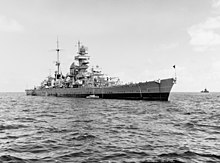Heavy cruiser



The heavy cruiser is a type of warship that developed after the First World War and soon disappeared again after the end of the Second World War . The heavy cruiser developed into an independent type of cruiser, mainly due to the technical specifications of the Washington Fleet Agreement . Heavy cruisers are cruisers whose main armament, unlike light cruisers, consists of guns with a caliber of more than 15.5 cm; a caliber of 20.3 cm (8 inches ) was common.
Precursor and beginning of development
Immediate forerunners of this type of ship were the Hawkins- class cruisers , which had been put into construction by the Royal Navy during World War I in order to obtain an effective remedy against the German small cruisers and auxiliary cruisers , which had seriously disrupted sea trade. They had an operational displacement of around 9,000 tons, a main armament of seven 19 cm guns and a speed of over 30 knots. This explains the qualitative maximum limits that the Washington Naval Conference of 1922 granted heavy cruisers: According to this, the standard displacement of this type could not exceed 10,000 tons (equivalent to 10,160 tons ) and the gun caliber could not exceed 20.3 cm (8 inches). Since the fleet conference also stipulated a 10-year construction break for capital ships, the large navies went over to an arms race in this class of ships. The average “heavy cruiser”, consequently also called the “Washington cruiser”, had eight or nine guns in twin or triple turrets, ran over 30 knots , but was only lightly armored.
Cruiser armament
The cruiser battle of the 1920s led to an attempt to contractually restrict their construction. A conference planned for this in Geneva did not materialize, so that a numerical upper limit for the number of cruisers in the fleets of Great Britain, the USA and Japan was not agreed until the next international fleet conference ( London 1930 ). The essential distinction between heavy and light cruisers was also established, according to which the latter were not allowed to have a caliber higher than 15.2 cm (6 inches).
Although built for all major navies, the guy was not particularly popular in high command. In an effort to exploit the caliber limitation as much as possible, ships were created that - measured against the size of 10,000 tons - were highly developed in terms of speed and armament, but were rather weak in terms of armor, range and seaworthiness. There were therefore some doubts, both in terms of its possible uses and its stability, that the construction of this type would be particularly useful. Only gradually did the realization gain acceptance that the ships needed stronger armor, which can be seen very well with the French Navy , which gradually developed its heavy cruisers from completely unprotected units to well-protected Algérie .
In Japan , starting with the Furutaka class , several classes of heavy cruisers had already been built from 1922. Under the restrictions of the fleet contracts of 1930, light cruisers of the Mogami class with 15.5 cm guns, heavy armor and extensive on-board flight facilities were built from 1931 onwards , which unofficially exceeded the 10,000 ton limit of the contracts by far. However, at the planning stage, they were designed to be converted to turrets with 20.3 cm guns if necessary, which then happened and turned them into full-fledged heavy cruisers from 1938.
As a result of the German-British naval agreement, the Kriegsmarine acquired the heavy cruisers of the Admiral Hipper class from 1935 , three of which were completed. In Germany, from 1940, the armored ships of the Deutschland class were also declared as heavy cruisers, but this reclassification was essentially for camouflage purposes; it does not correspond to the technical-tactical characteristics of these ships.
The heavy cruiser type was more or less abundant in all navies at the beginning of the Second World War . Even Argentina and Spain, which were not bound by any treaty, had such cruisers built. In 1939 the Royal Navy had 13, the US Navy and the Imperial Japanese Navy 18 heavy cruisers each. During the war, these ships were nicknamed "10-Minute Cruisers" to describe their short survival in combat. In the Pacific in particular, they carried a large part of the fighting during the Battle of Guadalcanal . Almost all navies went over to building light cruisers in the further course of the war; only the USA completed a good dozen units, most recently the Des Moines class , which with 20,000 tons, heavy armor and fully automatic artillery represented the maximum that could ever be extracted from this type of ship.
literature
- Siegfried Breyer: The "Washington cruisers" as a battleship replacement - origin and development of the heavy cruisers 1922-1939 . Podzun-Pallas, Friedberg, ISBN 3-7909-0442-2 (Volume 1) and ISBN 3-7909-0475-9 (Volume 2).
- Gino Galuppini: Guida agli incrociatori. Dalle origini ad oggi . (= Guide pratiche e manuali ). A. Mondadori, Milan 1982.
- Gerhard Koop, Klaus-Peter Schmolke: The heavy cruisers of the Admiral Hipper class. Admiral Hipper - Blücher - Prince Eugen Seydlitz - Lützow . (= Ship classes and ship types of the German Navy 3). Bernard and Graefe, Bonn 1992, ISBN 3-7637-5896-8 .
- MJ Whitley: Cruisers of world was two. An international encyclopedia . Naval Institute Press, Annapolis MD 1995, ISBN 1-55750-141-6 .